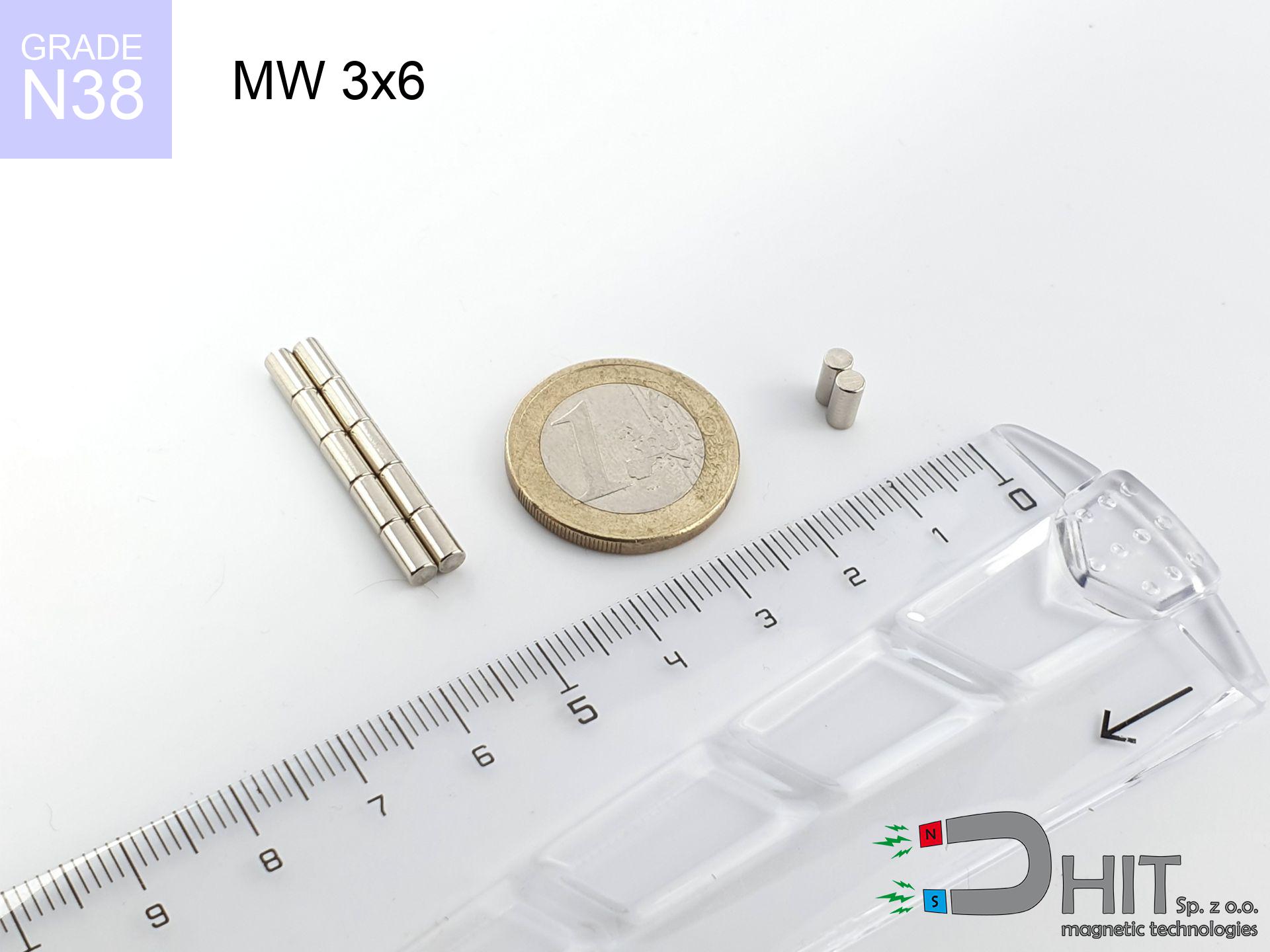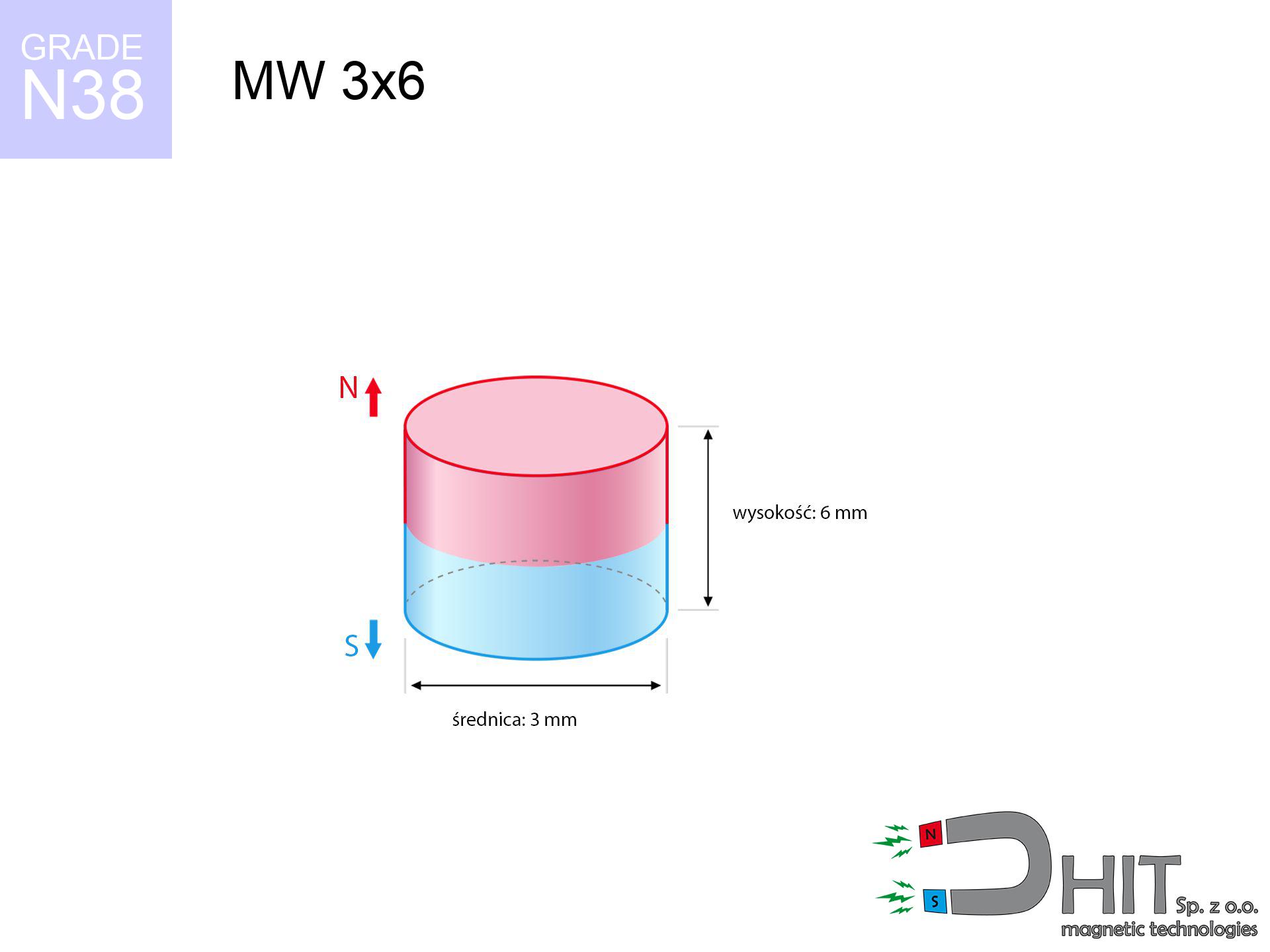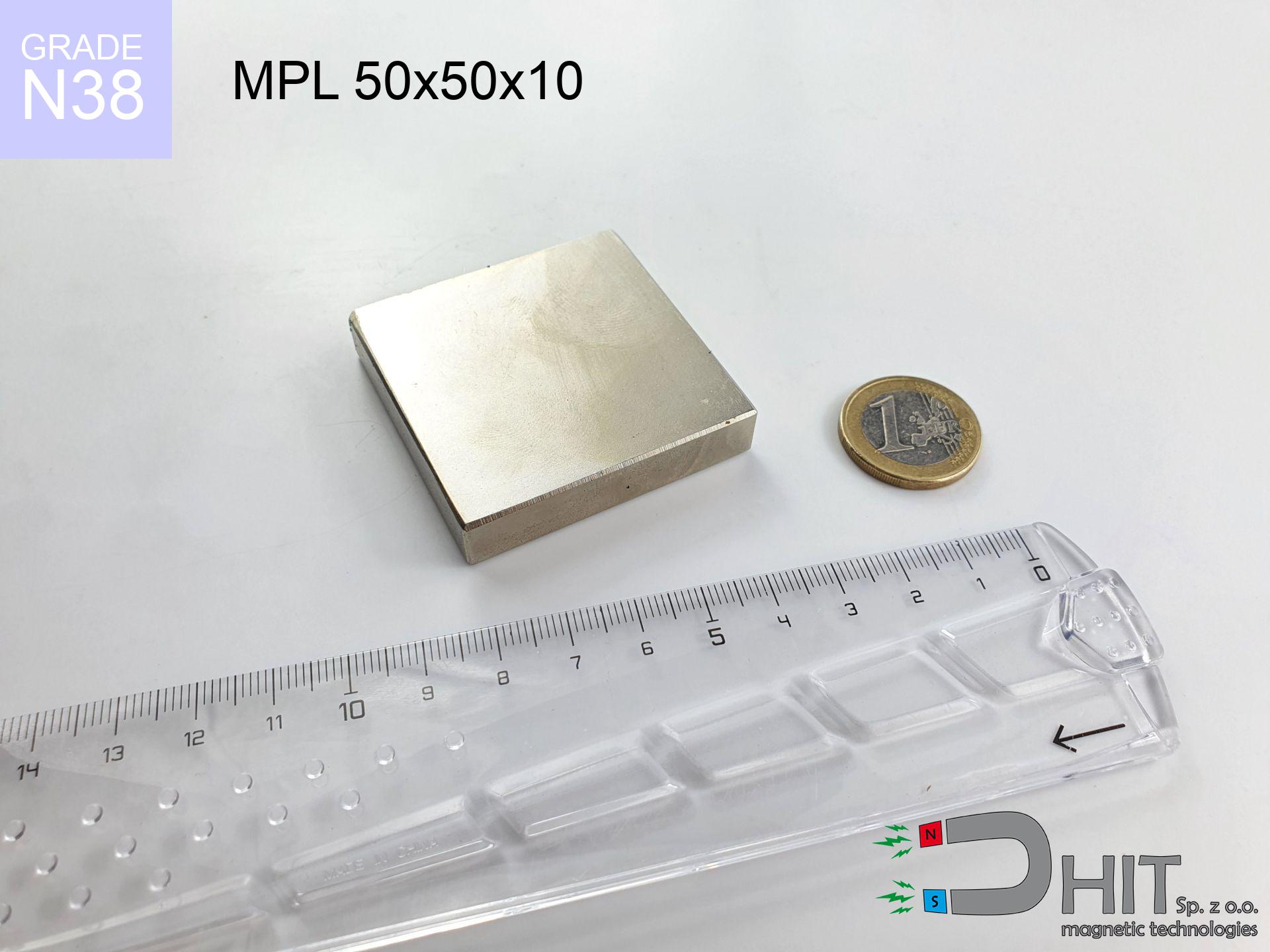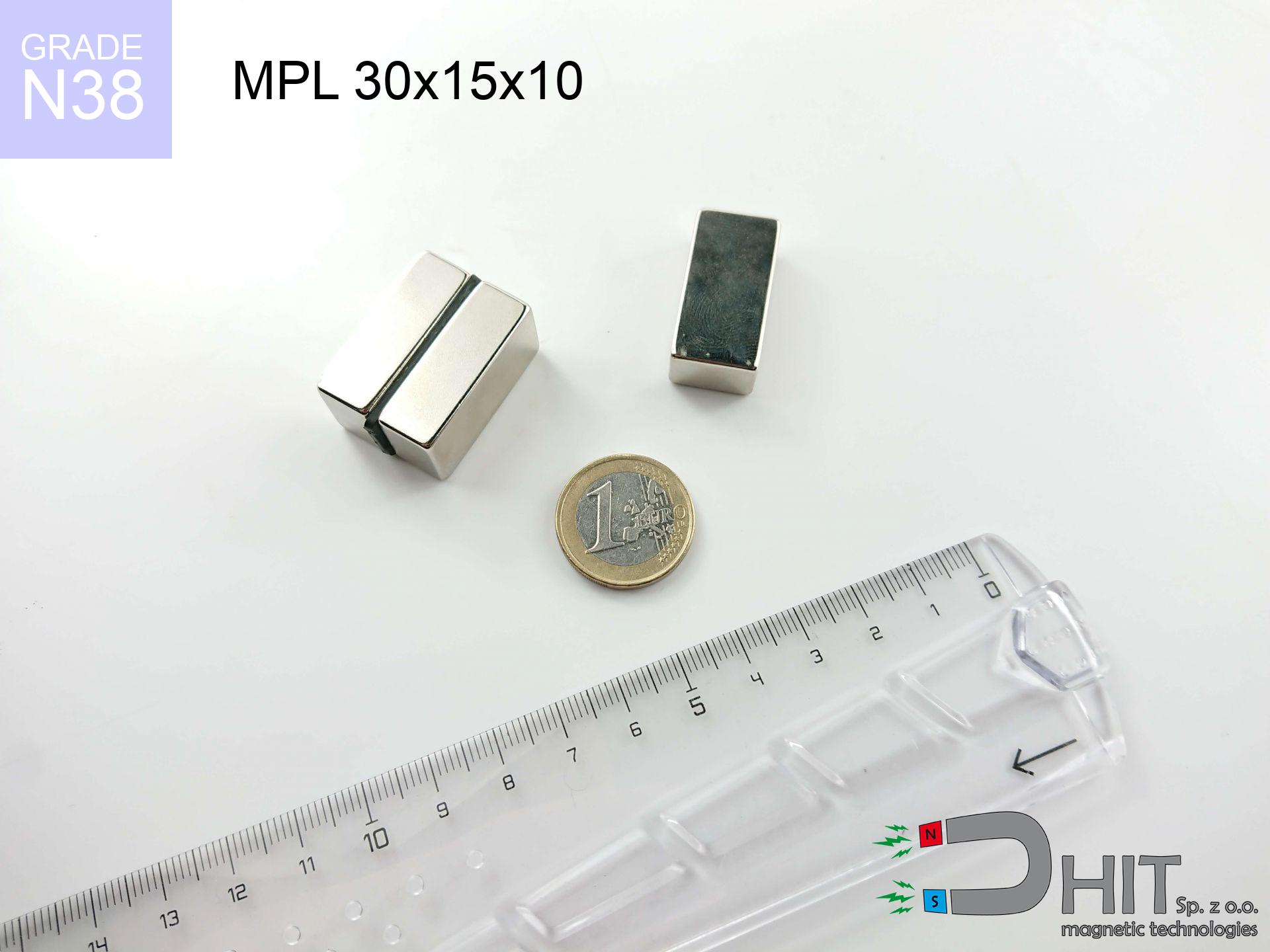MW 3x6 / N38 - cylindrical magnet
cylindrical magnet
Catalog no 010065
GTIN/EAN: 5906301810643
Diameter Ø
3 mm [±0,1 mm]
Height
6 mm [±0,1 mm]
Weight
0.32 g
Magnetization Direction
↑ axial
Load capacity
0.20 kg / 1.95 N
Magnetic Induction
598.96 mT / 5990 Gs
Coating
[NiCuNi] Nickel
0.295 ZŁ with VAT / pcs + price for transport
0.240 ZŁ net + 23% VAT / pcs
bulk discounts:
Need more?
Call us now
+48 888 99 98 98
if you prefer get in touch via
inquiry form
the contact page.
Specifications as well as shape of magnets can be tested on our
force calculator.
Same-day shipping for orders placed before 14:00.
Technical specification - MW 3x6 / N38 - cylindrical magnet
Specification / characteristics - MW 3x6 / N38 - cylindrical magnet
| properties | values |
|---|---|
| Cat. no. | 010065 |
| GTIN/EAN | 5906301810643 |
| Production/Distribution | Dhit sp. z o.o. |
| Country of origin | Poland / China / Germany |
| Customs code | 85059029 |
| Diameter Ø | 3 mm [±0,1 mm] |
| Height | 6 mm [±0,1 mm] |
| Weight | 0.32 g |
| Magnetization Direction | ↑ axial |
| Load capacity ~ ? | 0.20 kg / 1.95 N |
| Magnetic Induction ~ ? | 598.96 mT / 5990 Gs |
| Coating | [NiCuNi] Nickel |
| Manufacturing Tolerance | ±0.1 mm |
Magnetic properties of material N38
| properties | values | units |
|---|---|---|
| remenance Br [min. - max.] ? | 12.2-12.6 | kGs |
| remenance Br [min. - max.] ? | 1220-1260 | mT |
| coercivity bHc ? | 10.8-11.5 | kOe |
| coercivity bHc ? | 860-915 | kA/m |
| actual internal force iHc | ≥ 12 | kOe |
| actual internal force iHc | ≥ 955 | kA/m |
| energy density [min. - max.] ? | 36-38 | BH max MGOe |
| energy density [min. - max.] ? | 287-303 | BH max KJ/m |
| max. temperature ? | ≤ 80 | °C |
Physical properties of sintered neodymium magnets Nd2Fe14B at 20°C
| properties | values | units |
|---|---|---|
| Vickers hardness | ≥550 | Hv |
| Density | ≥7.4 | g/cm3 |
| Curie Temperature TC | 312 - 380 | °C |
| Curie Temperature TF | 593 - 716 | °F |
| Specific resistance | 150 | μΩ⋅cm |
| Bending strength | 250 | MPa |
| Compressive strength | 1000~1100 | MPa |
| Thermal expansion parallel (∥) to orientation (M) | (3-4) x 10-6 | °C-1 |
| Thermal expansion perpendicular (⊥) to orientation (M) | -(1-3) x 10-6 | °C-1 |
| Young's modulus | 1.7 x 104 | kg/mm² |
Technical modeling of the assembly - report
These information are the direct effect of a physical analysis. Values rely on models for the material Nd2Fe14B. Operational parameters might slightly differ. Treat these calculations as a reference point when designing systems.
Table 1: Static force (pull vs distance) - power drop
MW 3x6 / N38
| Distance (mm) | Induction (Gauss) / mT | Pull Force (kg/lbs/g/N) | Risk Status |
|---|---|---|---|
| 0 mm |
5974 Gs
597.4 mT
|
0.20 kg / 0.44 pounds
200.0 g / 2.0 N
|
weak grip |
| 1 mm |
2623 Gs
262.3 mT
|
0.04 kg / 0.09 pounds
38.6 g / 0.4 N
|
weak grip |
| 2 mm |
1134 Gs
113.4 mT
|
0.01 kg / 0.02 pounds
7.2 g / 0.1 N
|
weak grip |
| 3 mm |
570 Gs
57.0 mT
|
0.00 kg / 0.00 pounds
1.8 g / 0.0 N
|
weak grip |
| 5 mm |
205 Gs
20.5 mT
|
0.00 kg / 0.00 pounds
0.2 g / 0.0 N
|
weak grip |
| 10 mm |
42 Gs
4.2 mT
|
0.00 kg / 0.00 pounds
0.0 g / 0.0 N
|
weak grip |
| 15 mm |
15 Gs
1.5 mT
|
0.00 kg / 0.00 pounds
0.0 g / 0.0 N
|
weak grip |
| 20 mm |
7 Gs
0.7 mT
|
0.00 kg / 0.00 pounds
0.0 g / 0.0 N
|
weak grip |
| 30 mm |
2 Gs
0.2 mT
|
0.00 kg / 0.00 pounds
0.0 g / 0.0 N
|
weak grip |
| 50 mm |
1 Gs
0.1 mT
|
0.00 kg / 0.00 pounds
0.0 g / 0.0 N
|
weak grip |
Table 2: Slippage force (vertical surface)
MW 3x6 / N38
| Distance (mm) | Friction coefficient | Pull Force (kg/lbs/g/N) |
|---|---|---|
| 0 mm | Stal (~0.2) |
0.04 kg / 0.09 pounds
40.0 g / 0.4 N
|
| 1 mm | Stal (~0.2) |
0.01 kg / 0.02 pounds
8.0 g / 0.1 N
|
| 2 mm | Stal (~0.2) |
0.00 kg / 0.00 pounds
2.0 g / 0.0 N
|
| 3 mm | Stal (~0.2) |
0.00 kg / 0.00 pounds
0.0 g / 0.0 N
|
| 5 mm | Stal (~0.2) |
0.00 kg / 0.00 pounds
0.0 g / 0.0 N
|
| 10 mm | Stal (~0.2) |
0.00 kg / 0.00 pounds
0.0 g / 0.0 N
|
| 15 mm | Stal (~0.2) |
0.00 kg / 0.00 pounds
0.0 g / 0.0 N
|
| 20 mm | Stal (~0.2) |
0.00 kg / 0.00 pounds
0.0 g / 0.0 N
|
| 30 mm | Stal (~0.2) |
0.00 kg / 0.00 pounds
0.0 g / 0.0 N
|
| 50 mm | Stal (~0.2) |
0.00 kg / 0.00 pounds
0.0 g / 0.0 N
|
Table 3: Vertical assembly (sliding) - behavior on slippery surfaces
MW 3x6 / N38
| Surface type | Friction coefficient / % Mocy | Max load (kg/lbs/g/N) |
|---|---|---|
| Raw steel |
µ = 0.3
30% Nominalnej Siły
|
0.06 kg / 0.13 pounds
60.0 g / 0.6 N
|
| Painted steel (standard) |
µ = 0.2
20% Nominalnej Siły
|
0.04 kg / 0.09 pounds
40.0 g / 0.4 N
|
| Oily/slippery steel |
µ = 0.1
10% Nominalnej Siły
|
0.02 kg / 0.04 pounds
20.0 g / 0.2 N
|
| Magnet with anti-slip rubber |
µ = 0.5
50% Nominalnej Siły
|
0.10 kg / 0.22 pounds
100.0 g / 1.0 N
|
Table 4: Steel thickness (saturation) - sheet metal selection
MW 3x6 / N38
| Steel thickness (mm) | % power | Real pull force (kg/lbs/g/N) |
|---|---|---|
| 0.5 mm |
|
0.02 kg / 0.04 pounds
20.0 g / 0.2 N
|
| 1 mm |
|
0.05 kg / 0.11 pounds
50.0 g / 0.5 N
|
| 2 mm |
|
0.10 kg / 0.22 pounds
100.0 g / 1.0 N
|
| 3 mm |
|
0.15 kg / 0.33 pounds
150.0 g / 1.5 N
|
| 5 mm |
|
0.20 kg / 0.44 pounds
200.0 g / 2.0 N
|
| 10 mm |
|
0.20 kg / 0.44 pounds
200.0 g / 2.0 N
|
| 11 mm |
|
0.20 kg / 0.44 pounds
200.0 g / 2.0 N
|
| 12 mm |
|
0.20 kg / 0.44 pounds
200.0 g / 2.0 N
|
Table 5: Thermal stability (material behavior) - resistance threshold
MW 3x6 / N38
| Ambient temp. (°C) | Power loss | Remaining pull (kg/lbs/g/N) | Status |
|---|---|---|---|
| 20 °C | 0.0% |
0.20 kg / 0.44 pounds
200.0 g / 2.0 N
|
OK |
| 40 °C | -2.2% |
0.20 kg / 0.43 pounds
195.6 g / 1.9 N
|
OK |
| 60 °C | -4.4% |
0.19 kg / 0.42 pounds
191.2 g / 1.9 N
|
OK |
| 80 °C | -6.6% |
0.19 kg / 0.41 pounds
186.8 g / 1.8 N
|
|
| 100 °C | -28.8% |
0.14 kg / 0.31 pounds
142.4 g / 1.4 N
|
Table 6: Two magnets (repulsion) - field collision
MW 3x6 / N38
| Gap (mm) | Attraction (kg/lbs) (N-S) | Sliding Force (kg/lbs/g/N) | Repulsion (kg/lbs) (N-N) |
|---|---|---|---|
| 0 mm |
1.56 kg / 3.43 pounds
6 111 Gs
|
0.23 kg / 0.51 pounds
233 g / 2.3 N
|
N/A |
| 1 mm |
0.73 kg / 1.60 pounds
8 161 Gs
|
0.11 kg / 0.24 pounds
109 g / 1.1 N
|
0.65 kg / 1.44 pounds
~0 Gs
|
| 2 mm |
0.30 kg / 0.66 pounds
5 246 Gs
|
0.04 kg / 0.10 pounds
45 g / 0.4 N
|
0.27 kg / 0.60 pounds
~0 Gs
|
| 3 mm |
0.13 kg / 0.28 pounds
3 391 Gs
|
0.02 kg / 0.04 pounds
19 g / 0.2 N
|
0.11 kg / 0.25 pounds
~0 Gs
|
| 5 mm |
0.03 kg / 0.06 pounds
1 578 Gs
|
0.00 kg / 0.01 pounds
4 g / 0.0 N
|
0.02 kg / 0.05 pounds
~0 Gs
|
| 10 mm |
0.00 kg / 0.00 pounds
409 Gs
|
0.00 kg / 0.00 pounds
0 g / 0.0 N
|
0.00 kg / 0.00 pounds
~0 Gs
|
| 20 mm |
0.00 kg / 0.00 pounds
83 Gs
|
0.00 kg / 0.00 pounds
0 g / 0.0 N
|
0.00 kg / 0.00 pounds
~0 Gs
|
| 50 mm |
0.00 kg / 0.00 pounds
8 Gs
|
0.00 kg / 0.00 pounds
0 g / 0.0 N
|
0.00 kg / 0.00 pounds
~0 Gs
|
| 60 mm |
0.00 kg / 0.00 pounds
5 Gs
|
0.00 kg / 0.00 pounds
0 g / 0.0 N
|
0.00 kg / 0.00 pounds
~0 Gs
|
| 70 mm |
0.00 kg / 0.00 pounds
3 Gs
|
0.00 kg / 0.00 pounds
0 g / 0.0 N
|
0.00 kg / 0.00 pounds
~0 Gs
|
| 80 mm |
0.00 kg / 0.00 pounds
2 Gs
|
0.00 kg / 0.00 pounds
0 g / 0.0 N
|
0.00 kg / 0.00 pounds
~0 Gs
|
| 90 mm |
0.00 kg / 0.00 pounds
2 Gs
|
0.00 kg / 0.00 pounds
0 g / 0.0 N
|
0.00 kg / 0.00 pounds
~0 Gs
|
| 100 mm |
0.00 kg / 0.00 pounds
1 Gs
|
0.00 kg / 0.00 pounds
0 g / 0.0 N
|
0.00 kg / 0.00 pounds
~0 Gs
|
Table 7: Hazards (electronics) - precautionary measures
MW 3x6 / N38
| Object / Device | Limit (Gauss) / mT | Safe distance |
|---|---|---|
| Pacemaker | 5 Gs (0.5 mT) | 2.5 cm |
| Hearing aid | 10 Gs (1.0 mT) | 2.0 cm |
| Mechanical watch | 20 Gs (2.0 mT) | 1.5 cm |
| Mobile device | 40 Gs (4.0 mT) | 1.5 cm |
| Car key | 50 Gs (5.0 mT) | 1.0 cm |
| Payment card | 400 Gs (40.0 mT) | 0.5 cm |
| HDD hard drive | 600 Gs (60.0 mT) | 0.5 cm |
Table 8: Impact energy (cracking risk) - collision effects
MW 3x6 / N38
| Start from (mm) | Speed (km/h) | Energy (J) | Predicted outcome |
|---|---|---|---|
| 10 mm |
25.21 km/h
(7.00 m/s)
|
0.01 J | |
| 30 mm |
43.67 km/h
(12.13 m/s)
|
0.02 J | |
| 50 mm |
56.38 km/h
(15.66 m/s)
|
0.04 J | |
| 100 mm |
79.73 km/h
(22.15 m/s)
|
0.08 J |
Table 9: Corrosion resistance
MW 3x6 / N38
| Technical parameter | Value / Description |
|---|---|
| Coating type | [NiCuNi] Nickel |
| Layer structure | Nickel - Copper - Nickel |
| Layer thickness | 10-20 µm |
| Salt spray test (SST) ? | 24 h |
| Recommended environment | Indoors only (dry) |
Table 10: Construction data (Pc)
MW 3x6 / N38
| Parameter | Value | SI Unit / Description |
|---|---|---|
| Magnetic Flux | 470 Mx | 4.7 µWb |
| Pc Coefficient | 1.21 | High (Stable) |
Table 11: Physics of underwater searching
MW 3x6 / N38
| Environment | Effective steel pull | Effect |
|---|---|---|
| Air (land) | 0.20 kg | Standard |
| Water (riverbed) |
0.23 kg
(+0.03 kg buoyancy gain)
|
+14.5% |
1. Wall mount (shear)
*Warning: On a vertical surface, the magnet retains only approx. 20-30% of its nominal pull.
2. Efficiency vs thickness
*Thin metal sheet (e.g. computer case) severely reduces the holding force.
3. Temperature resistance
*For N38 material, the critical limit is 80°C.
4. Demagnetization curve and operating point (B-H)
chart generated for the permeance coefficient Pc (Permeance Coefficient) = 1.21
This simulation demonstrates the magnetic stability of the selected magnet under specific geometric conditions. The solid red line represents the demagnetization curve (material potential), while the dashed blue line is the load line based on the magnet's geometry. The Pc (Permeance Coefficient), also known as the load line slope, is a dimensionless value that describes the relationship between the magnet's shape and its magnetic stability. The intersection of these two lines (the black dot) is the operating point — it determines the actual magnetic flux density generated by the magnet in this specific configuration. A higher Pc value means the magnet is more 'slender' (tall relative to its area), resulting in a higher operating point and better resistance to irreversible demagnetization caused by external fields or temperature. A value of 0.42 is relatively low (typical for flat magnets), meaning the operating point is closer to the 'knee' of the curve — caution is advised when operating at temperatures near the maximum limit to avoid strength loss.
Material specification
| iron (Fe) | 64% – 68% |
| neodymium (Nd) | 29% – 32% |
| boron (B) | 1.1% – 1.2% |
| dysprosium (Dy) | 0.5% – 2.0% |
| coating (Ni-Cu-Ni) | < 0.05% |
Sustainability
| recyclability (EoL) | 100% |
| recycled raw materials | ~10% (pre-cons) |
| carbon footprint | low / zredukowany |
| waste code (EWC) | 16 02 16 |
View also offers
Pros as well as cons of neodymium magnets.
Strengths
- They have stable power, and over nearly ten years their performance decreases symbolically – ~1% (according to theory),
- They are noted for resistance to demagnetization induced by external magnetic fields,
- The use of an elegant layer of noble metals (nickel, gold, silver) causes the element to have aesthetics,
- Magnetic induction on the top side of the magnet remains impressive,
- Due to their durability and thermal resistance, neodymium magnets can operate (depending on the shape) even at high temperatures reaching 230°C or more...
- Thanks to the potential of accurate forming and adaptation to individualized projects, neodymium magnets can be created in a broad palette of geometric configurations, which amplifies use scope,
- Fundamental importance in advanced technology sectors – they serve a role in computer drives, brushless drives, advanced medical instruments, as well as multitasking production systems.
- Thanks to concentrated force, small magnets offer high operating force, occupying minimum space,
Weaknesses
- Brittleness is one of their disadvantages. Upon intense impact they can break. We advise keeping them in a special holder, which not only protects them against impacts but also increases their durability
- We warn that neodymium magnets can lose their strength at high temperatures. To prevent this, we recommend our specialized [AH] magnets, which work effectively even at 230°C.
- Magnets exposed to a humid environment can rust. Therefore during using outdoors, we recommend using waterproof magnets made of rubber, plastic or other material resistant to moisture
- Limited ability of creating threads in the magnet and complex forms - preferred is casing - mounting mechanism.
- Potential hazard related to microscopic parts of magnets are risky, when accidentally swallowed, which becomes key in the aspect of protecting the youngest. Furthermore, small components of these magnets can disrupt the diagnostic process medical when they are in the body.
- High unit price – neodymium magnets cost more than other types of magnets (e.g. ferrite), which hinders application in large quantities
Pull force analysis
Magnetic strength at its maximum – what affects it?
- using a plate made of low-carbon steel, serving as a ideal flux conductor
- with a cross-section no less than 10 mm
- characterized by lack of roughness
- with total lack of distance (without impurities)
- for force acting at a right angle (in the magnet axis)
- in neutral thermal conditions
Magnet lifting force in use – key factors
- Distance (between the magnet and the metal), as even a tiny distance (e.g. 0.5 mm) can cause a drastic drop in lifting capacity by up to 50% (this also applies to paint, corrosion or debris).
- Force direction – catalog parameter refers to pulling vertically. When applying parallel force, the magnet exhibits much less (often approx. 20-30% of maximum force).
- Base massiveness – insufficiently thick steel causes magnetic saturation, causing part of the power to be escaped into the air.
- Metal type – not every steel attracts identically. Alloy additives worsen the interaction with the magnet.
- Plate texture – ground elements guarantee perfect abutment, which increases field saturation. Uneven metal weaken the grip.
- Thermal environment – heating the magnet causes a temporary drop of induction. It is worth remembering the maximum operating temperature for a given model.
Lifting capacity was determined by applying a polished steel plate of optimal thickness (min. 20 mm), under perpendicular pulling force, whereas under shearing force the holding force is lower. In addition, even a small distance between the magnet’s surface and the plate reduces the lifting capacity.
Precautions when working with NdFeB magnets
Product not for children
Always keep magnets away from children. Choking hazard is high, and the consequences of magnets connecting inside the body are tragic.
Fragile material
Watch out for shards. Magnets can fracture upon uncontrolled impact, launching sharp fragments into the air. Eye protection is mandatory.
Avoid contact if allergic
A percentage of the population suffer from a sensitization to nickel, which is the typical protective layer for neodymium magnets. Prolonged contact may cause an allergic reaction. We recommend use protective gloves.
Implant safety
Patients with a ICD should keep an absolute distance from magnets. The magnetic field can disrupt the functioning of the life-saving device.
Phone sensors
An intense magnetic field interferes with the functioning of magnetometers in phones and GPS navigation. Maintain magnets close to a smartphone to prevent damaging the sensors.
Demagnetization risk
Do not overheat. NdFeB magnets are susceptible to heat. If you need operation above 80°C, ask us about HT versions (H, SH, UH).
Dust is flammable
Combustion risk: Rare earth powder is highly flammable. Do not process magnets without safety gear as this risks ignition.
Powerful field
Before starting, check safety instructions. Uncontrolled attraction can break the magnet or hurt your hand. Be predictive.
Finger safety
Danger of trauma: The pulling power is so immense that it can cause hematomas, pinching, and even bone fractures. Use thick gloves.
Protect data
Avoid bringing magnets close to a purse, laptop, or TV. The magnetic field can irreversibly ruin these devices and wipe information from cards.





![MPL 40x15x5x2[7/3.5] / N38 - lamellar magnet MPL 40x15x5x2[7/3.5] / N38 - lamellar magnet](https://cdn3.dhit.pl/graphics/products/mpl-40x15x5x27-3.5-cas.jpg)



